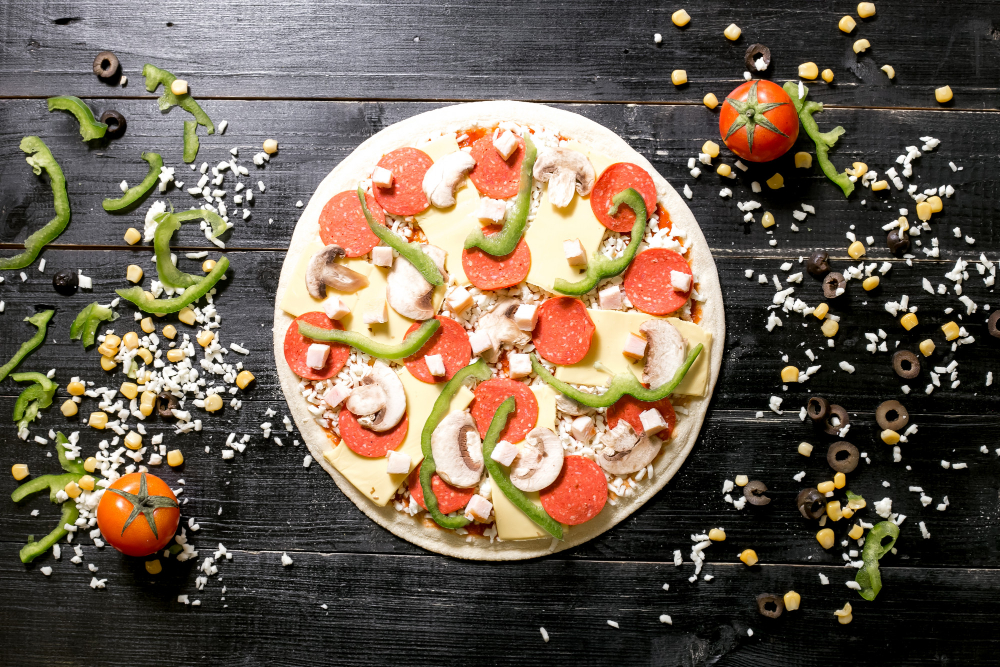Pizza often gets a bad rap in the world of healthy eating, but what if we told you that not all pizza is created equal? If you’re a pizza lover trying to eat a little better, you may have heard that thin crust pizza is a healthier alternative. But is it really? According to nutritionists, the answer isn’t black and white—it depends on what you put on it, how much you eat, and how it’s made.
In this article, we’ll break down what nutrition experts say about Thin Crust Pizza, compare it to other types of pizza, and help you make smarter choices without giving up your favorite comfort food.
What Makes Thin Crust Pizza Different?
The most obvious difference between thin crust pizza and regular or deep-dish varieties is the thickness of the crust. While deep-dish pizza often has a rich, buttery, and thick base loaded with cheese and sauce, thin crust pizza offers a lighter, crispier alternative.
Key differences:
- Less dough = fewer calories and carbs
- Crispers texture and quicker cook time
- More surface area for toppings, but often fewer layers of cheese
This structural change alone can make a significant nutritional difference.
Fewer Calories and Carbs
According to nutritionists, one of the main reasons thin crust pizza is considered healthier is its lower calorie and carbohydrate count. Traditional thick crust pizza can add hundreds of extra calories just from the dough.
For example:
- A single slice of thin crust cheese pizza (regular size) averages around 200–250 calories.
- The same slice of thick crust pizza might clock in at 300–400 calories or more.
That difference adds up fast—especially when you go for multiple slices!
Nutritionist Insight: “The thinner the crust, the fewer refined carbs you’re consuming. If you’re watching your calorie intake or managing your blood sugar levels, thin crust is the smarter option,” says registered dietitian Lisa Andrews, MEd, RD, LD.
Lower in Saturated Fats (If Topped Wisely)
Fat content in pizza largely depends on toppings and cheese quantity. Since thin crust pizza often has less dough to absorb oil or support loads of cheese, many versions naturally contain less saturated fat.
That said, your health halo disappears if you pile on processed meats like pepperoni, sausage, or bacon. To keep your thin crust pizza healthier:
Choose:
- Lean proteins like grilled chicken or turkey
- Vegetables like mushrooms, spinach, and bell peppers
- Light cheese or go easy on the mozzarella
“Fat itself isn’t bad, but quality matters. A vegetable-loaded thin crust pizza with light cheese is a balanced meal,” explains nutritionist Dana Ellis Hunnes, PhD, RD, MPH.
Better Portion Control
It’s easier to manage portions with thin crust pizza because you often feel satisfied with fewer slices. The crisp, cracker-like base gives you the crunch you crave without the bloated feeling that can come from heavy, doughy pizza.
Thin crust also encourages mindful eating. You’re more likely to savor each bite when it’s not drowning in sauce and cheese.
Nutritional Comparisons: Thin Crust vs. Others
Let’s take a closer look at how thin crust pizza compares nutritionally with other popular crust types:
| Pizza Type | Calories (per slice) | Carbs (g) | Fat (g) | Protein (g) |
|---|---|---|---|---|
| Thin Crust Cheese | ~220 | ~25 | ~9 | ~10 |
| Regular Crust | ~285 | ~34 | ~11 | ~12 |
| Deep Dish | ~350–400 | ~40–45 | ~16 | ~14 |
| Cauliflower Crust | ~150–180 | ~15 | ~7 | ~9 |
Note: Actual values may vary based on brand, size, and ingredients used.
Whole Wheat or Cauliflower Thin Crust: Even Better?
If you’re looking to take your healthy pizza game up a notch, consider trying whole wheat or cauliflower-based thin crust pizza options. These crusts add nutritional value with fiber, vitamins, and fewer refined carbs.
- Whole wheat thin crust adds fiber, which helps with digestion and keeps you fuller longer.
- Cauliflower thin crust is great for gluten-free diets and offers a veggie boost with fewer carbs.
Just be cautious—some cauliflower crusts still contain refined flour or added cheese, so always check the ingredients if you’re watching calories or sodium.
Homemade Thin Crust Pizza: The Healthiest Option
When you make crust pizza at home, you have complete control over what goes into it. You can choose whole-food ingredients, skip unnecessary oils, and load it with nutrient-dense toppings.
Healthier homemade toppings:
- Tomato sauce made with no added sugar
- Fresh vegetables like arugula, zucchini, and roasted red peppers
- Herbs and spices for flavor instead of salt
- Light cheese or dairy-free alternatives
Baking your own thin crust pizza is not only healthier, but also a fun activity that lets you customize every bite.
When Thin Crust Isn’t Healthier
While pizza often has advantages, it’s not automatically healthy just because the crust is thinner. Here are some scenarios where thin crust loses its edge:
- Excessive cheese: Double cheese = double fat and sodium
- Greasy meats: Pepperoni and sausage add unnecessary saturated fat
- Cream-based sauces: Alfredo or ranch-based sauces can add hidden calories
- Oversized portions: Eating a whole 12-inch pizza still packs in calories, thin crust or not
It’s all about balance,” says Andrews. “Even with thin crust, your toppings, portion size, and overall diet matter most.
Verdict: Is Thin Crust Pizza Healthier?
Yes—thin crust pizza can be a healthier choice, especially when compared to thick crust or deep-dish varieties. It’s typically lower in calories, carbs, and fat, and allows more room for healthy toppings like veggies and lean proteins.
But the real secret lies in how you top it, how much you eat, and whether it’s part of a balanced lifestyle.
Quick Tips for a Healthier Pizza Night
- Stick to veggie-heavy toppings
- Go light on the cheese or use reduced-fat versions
- Opt for homemade or trusted local options over greasy fast-food chains
- Watch your portion size—2–3 slices is a reasonable serving
- Pair with a salad or roasted veggies for a balanced meal
Final Thoughts
Pizza doesn’t have to be your guilty pleasure—it can actually be a smart and satisfying choice, especially when you opt for crust pizza with nutritious toppings and mindful portions. Whether you’re grabbing a slice from your favorite pizzeria or whipping up your own version at home, small tweaks can make a big difference.
So the next time you crave pizza, don’t shy away—just go thin crust, pile on the veggies, and enjoy it the healthy way.








